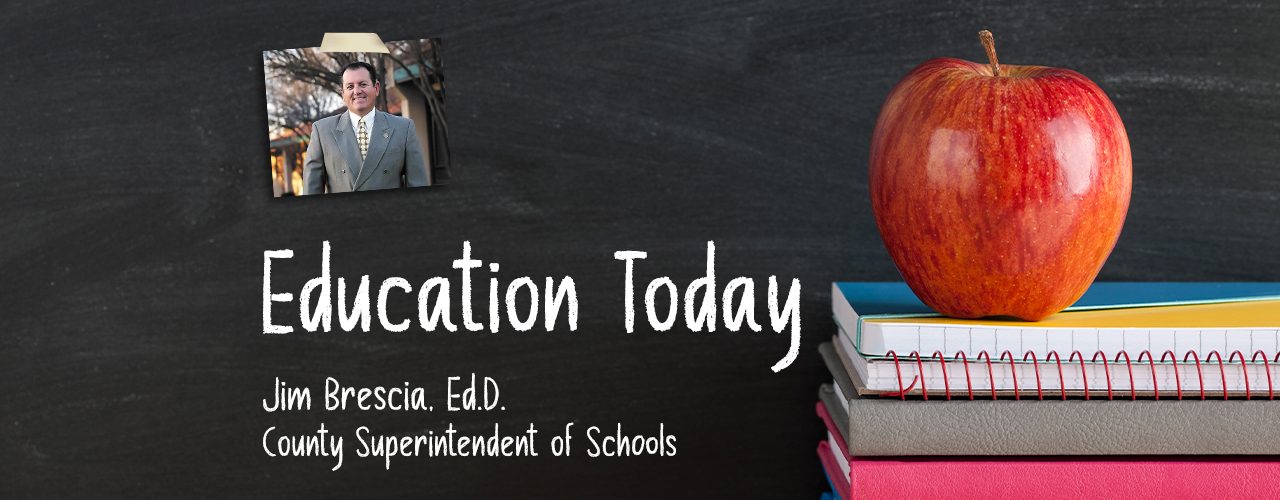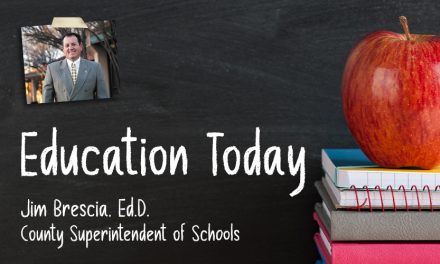By JIM BRESCIA, Ed.D, County Superintendent of Schools
According to Google, the three most highly searched words/phrases during 2020 were election results, Coronavirus, and Kobe Bryant. A quick review of the Google Trends for 2020 will inform historians that 2020 was a year like no other to this generation. COVID-19 enveloped all aspects of life and education in California. The pandemic uprooted families, forced the conversion of bedrooms into classrooms, restricted in-person social gatherings, and prevented the daily student interactions we traditionally embraced. Today we measure the daily rhythms of school in learning loss and screen time. Along with the distance learning challenges 2020 presented, we faced fires, public protests, election challenges, new California higher education leaders, and the repulsive violent actions against the United States Capitol.
This month’s article is my review of how 2020 disrupted and transformed California schools, focusing on our dedicated public servants.
On March 5, a day after Gov. Gavin Newsom issued a state of emergency, a few California schools stopped in-person instruction, which was the start of California schools transitioning to distance instruction. During the early hours of Sunday, March 8, our home phone rang, and all 58 county superintendents were summoned to Sacramento to meet with the Governor for a briefing on COVID-19 specific to schools. On Friday, March 13, while hosting our monthly superintendent’s council for the district, charter, college, and university leaders in our county, mobile phones began to vibrate throughout the room. Each school leader was being called back to emergency meetings with their governing boards, almost as if we were characters in a science fiction or thriller movie, all receiving the same message. “REPORT BACK TO HEADQUARTERS IMMEDIATELY.”
What followed were disappointments and missed timelines as school leaders struggled to follow COVID-19 protocols, continue providing educational services, adapting to a shifting landscape, and preparing for mid-year budget reductions.
2020 began with Governor Newsom’s optimistic budget projections that drastically changed in June, with billions in budget cuts to higher education and state funding deferrals for K-12. This news was followed by larger than expected tax revenues and a strong stock market that lessened the education blow. Additionally, Congress passed COVID-19 relief legislation in March and again in December, helping education start 2021 on a more stable fiscal footing. Unfortunately, districts across California, including several in our county, face a future of growing austerity and have reduced program offerings because of prior budget shortfalls compounded by the pandemic. The savings from reduced travel and building operations have lessened the cuts, and many of our districts will adapt practices to maintain fiscal stewardship moving forward.
2020 presented the world of higher education with two new leaders taking charge of the state’s university systems. In July, the University of California regents named Michal V. Drake to succeed Janet Napolitano as president of the University of California. In September, the California State University trustees selected Fresno State President Joseph Castro to replace the retiring Chancellor Timothy White. Together with Eloy Ortiz Oakley, chancellor of the California Community Colleges, and California State Superintendent of Public Instruction Tony Thurmond, for the first time, all four of California’s public education systems will be led by people of color.
2020 also impacted our childcare centers that operate on thin margins, with underpaid staff. Childcare has continued to provide services throughout the pandemic at reduced capacity with the support of donations and emergency funding. Childcare centers and all other educational agencies received Personal Protective Equipment (PPE) and assistance with ongoing COVID-19 testing practices. We are hopeful that with the additional funds Congress and our state budget have added, childcare may not only maintain services but implement long-term gains. Locally, First 5 SLO, CAPSLO, Cuesta College, Trust Automation, the Childcare Planning Council, several cities, county government, my office, and several other agencies are continuing the dialogue about childcare’s economic importance.
During the first month of 2021, schools across San Luis Obispo County implemented additional in-person services and continued to plan to increase operations as conditions permit. One parent described in a detailed email the first month of distance education feeling like an “explosion at the kitchen table.” Understanding these sentiments, families, educators, support staff, and community members have all stepped in to assist during these difficult times. Our community manifests a “Can Do” spirit and is rising to meet the challenge.
Everyone hopes that we can return to schools, friends, and normalcy as soon as possible. As our community vaccination continues, I am confident that we will move forward, continue to increase in-person services, and look back on 2020 as a year like no other. It is an honor to serve as your county superintendent of schools.
Thank you, San Luis Obispo County, for doing your part.







